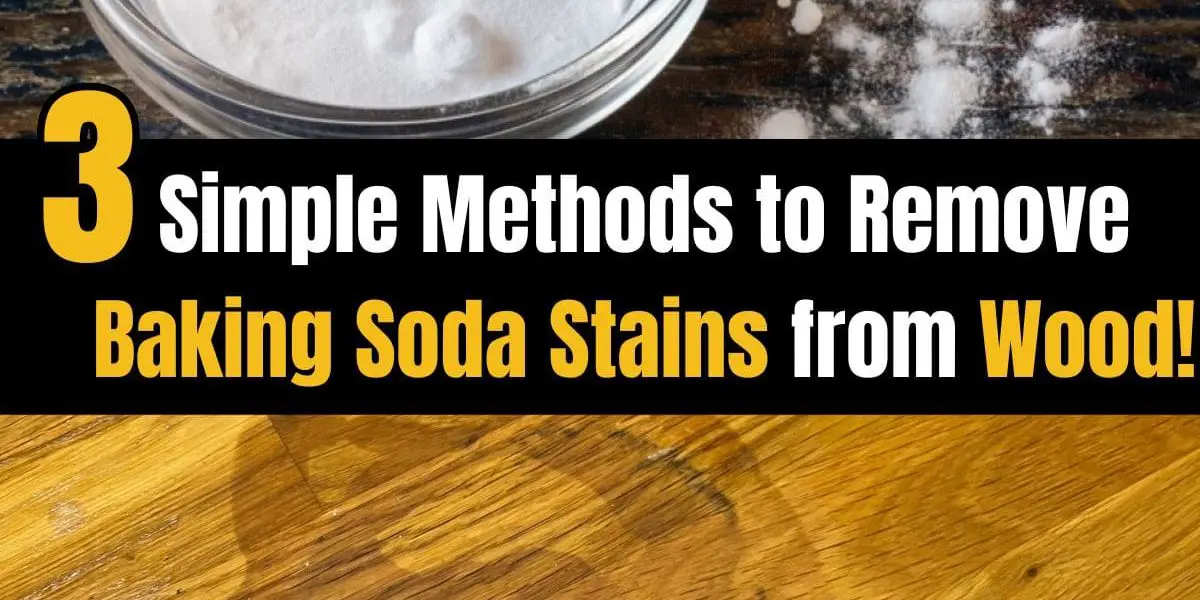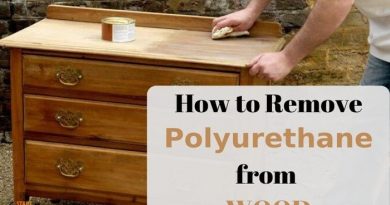How to Easily Remove Baking Soda Stains from Wood Surfaces!
Got baking soda stains on your wood? Don’t worry! Just follow these steps: grab a soft cloth, make a vinegar-water solution, gently blot the stain, and then buff the wood surface in circular motions. Finish with a nourishing oil rub to rejuvenate your wood’s luster. With this quick routine, you can erase those baking soda marks and get your wood looking brand new again.
Method #1. Using Oxalic Acid
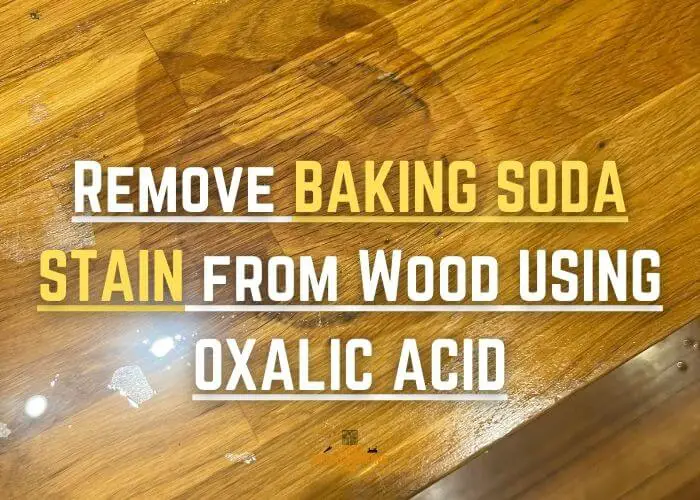
1. Prepare the Area
Begin by ensuring your workspace is well-ventilated because oxalic acid can be harmful if inhaled. Put on your safety gear, including gloves, goggles, and a mask, to protect yourself from the acid.
2. Mixing the Solution
I carefully mix the oxalic acid crystals with warm water, following the manufacturer’s instructions for the correct ratio. Typically, I use hot water as it dissolves the crystals more effectively, creating a more consistent solution.
3. Applying Oxalic Acid
With a clean brush, I apply the oxalic acid solution evenly across the stained area, extending slightly beyond the stain itself to avoid creating a spot treatment effect. I make sure the area is covered but not oversaturated, as too much liquid can damage the wood.
4. Allowing Time to Work
I leave the solution on the stain long enough to lighten it, which can take anywhere from 10 minutes to a few hours, depending on the severity of the stain. I keep an eye on the progress, ensuring the wood does not become too bleached.
5. Neutralizing and Rinsing
Once the stain has lightened satisfactorily, I rinse the area thoroughly with clean water to remove any residual acid. I then neutralize the wood by wiping it down with a baking soda and water solution, which prevents the acid from continuing to react with the wood.
6. Drying and Refinishing
After the wood is completely dry, I assess the need for refinishing. If the oxalic acid has stripped some of the finish, I sand the area lightly with fine-grit sandpaper and then reapply a matching finish to restore the wood’s protective layer and appearance.
Pros:
- Effective on Deep Stains: Oxalic acid is powerful and can remove stains that have penetrated deeply into the wood grain, which might not be possible with less aggressive methods.
- Restores Natural Color: It can help in restoring the wood’s natural color by effectively bleaching the stained area.
- Versatile: This method can be used on a variety of wood types and finishes, especially on unfinished or raw wood where other methods might fail.
Cons:
- Harsh Chemical: Oxalic acid is a strong chemical that can be harmful if not handled properly, requiring protective gear and proper ventilation.
- Potential for Damage: If not used correctly, oxalic acid can overly bleach the wood or damage the finish, necessitating refinishing.
- Finish Compatibility: On certain finishes, particularly those that are not acid-resistant, oxalic acid can cause deterioration or discoloration.
Type of Wood Surface and Finish Considerations:
- Unfinished Wood: Oxalic acid works well on unfinished wood but can change its color, so it’s important to test in an inconspicuous area first.
- Finished Wood: If the wood has a finish, oxalic acid may remove or alter it, so additional steps for refinishing will be necessary.
- Delicate Wood: For woods that are soft or delicate, such as pine, it’s crucial to monitor the application closely to prevent damage.
- Dark Woods: On darker woods, oxalic acid may cause noticeable lightening, which could require staining to match the original color.
Method #2. Vinegar and Olive Oil
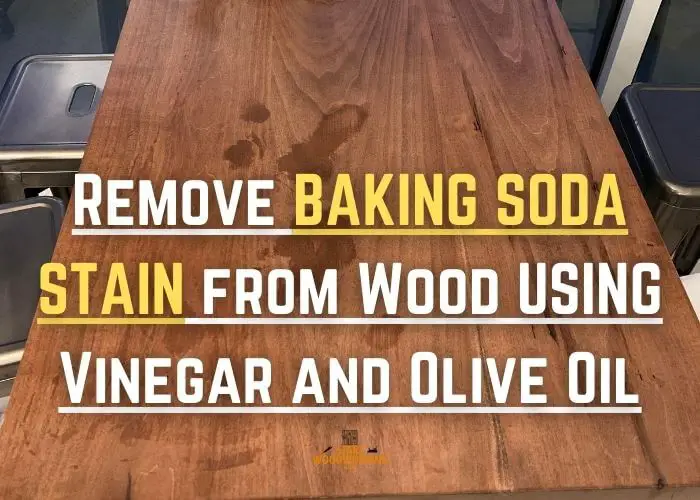
1. Create the Mixture
I prepare a solution by mixing equal parts of white vinegar and olive oil. The vinegar acts as a mild acid to help lift the stain, while the olive oil nourishes the wood and helps to restore its natural luster.
2. Apply the Solution
Using a soft, lint-free cloth, I apply the mixture to the stained area, following the grain of the wood. I use a gentle rubbing motion to work the solution into the stain. It’s important not to soak the wood; just a light application will do.
3. Allow Time to React
After applying the mixture, I let it sit for a few minutes. This gives the vinegar time to interact with the baking soda residue. The olive oil simultaneously penetrates the wood, conditioning it and preventing the vinegar from drying it out.
4. Wipe and Buff
Using a clean, dry cloth, I wipe away the mixture, again following the grain of the wood. If the stain persists, I might repeat the application, being careful not to overdo it to avoid oil buildup. Once the baking soda stain is removed, I buff the wood with another clean cloth to bring out the shine.
5. Final Inspection
I inspect the wood under good lighting to ensure the stain is completely gone and that the wood’s finish looks even. If necessary, I’ll go over the area once more with a fresh cloth to ensure no oily residue is left behind.
Pros:
- Gentle on Wood: The mixture is mild and less likely to damage the wood’s surface compared to harsher chemical cleaners.
- Conditioning Properties: Olive oil can help to condition the wood and restore its natural shine after the vinegar has done its job lifting the stain.
- Eco-Friendly: This method uses natural, non-toxic ingredients that are safer for the environment and the user.
- Easy to Prepare and Use: The solution is simple to make with common household ingredients and is easy to apply.
Cons:
- May Not Work on All Finishes: Depending on the wood’s finish, vinegar might not be suitable and could potentially dull or damage certain finishes.
- Potential for Oil Residue: If too much olive oil is used or it’s not properly buffed out, it could leave an oily residue that attracts dust.
- Mild Cleaning Power: While effective for mild stains, this method may not be strong enough for more severe or deeply set stains.
- Requires Elbow Grease: It might require a bit of effort to rub the solution into the stain and buff the wood to a shine.
Type of Wood Surface and Finish Considerations:
- Finished Wood: On wood with a protective coating, such as polyurethane, the vinegar might not penetrate the stain as effectively, and the olive oil could interact with the finish.
- Unfinished or Raw Wood: The method works well on unfinished wood, as the vinegar can directly access the stain and the olive oil can penetrate and condition the wood.
- Delicate Finishes: For delicate finishes or antique furniture, it’s important to test this method in an inconspicuous area first to ensure it doesn’t cause damage.
Method #3. Sanding
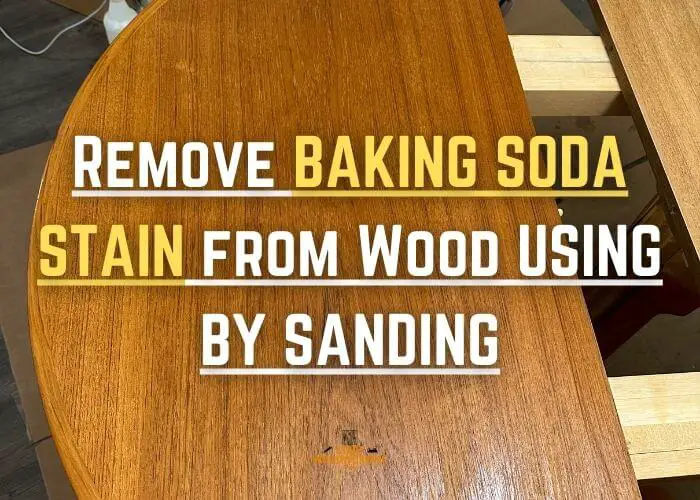
1. Choose the Right Sandpaper
I start with a medium-grit sandpaper, around 120- to 150-grit, to remove the surface layer of the stain. I always sand in the direction of the wood grain to avoid creating scratches that go against the natural pattern of the wood fibers.
2. Gentle Sanding
Using a sanding block for even pressure, I gently sand the stained area. The goal is to remove the stain without taking off too much of the wood surface. I periodically wipe away the dust with a tack cloth to check my progress.
3. Finer Grit for Finishing
Once the stain is no longer visible, I switch to a finer grit sandpaper, like 220-grit, to smooth out the area. This step ensures that the surface will be ready for refinishing and that there won’t be any noticeable dips or grooves.
4. Clean the Surface
After sanding to my satisfaction, I thoroughly clean the area of all sawdust using a vacuum and a tack cloth. It’s crucial to remove all residue to ensure a clean, smooth finish when refinishing.
5. Refinish the Wood
Finally, I match the finish to the rest of the wood surface. This might involve staining to match the existing color and then applying a topcoat, such as polyurethane, to protect the wood and give it a uniform appearance.
Pros:
- Effectiveness: Sanding is very effective at removing the outermost layer of a stain, making it a good option for stains that have not penetrated deeply.
- Precision: By using different grits of sandpaper, you can precisely control the amount of wood you’re removing.
- Immediate Results: Sanding provides immediate feedback on your progress, as you can see the stain being removed as you work.
- Restores Surface: It can smooth out the wood surface, preparing it for refinishing, which can restore the wood’s appearance to its original condition.
Cons:
- Potential Damage to Wood: If not done carefully, sanding can remove too much material and damage the wood surface, leading to unevenness or thinning of the wood.
- Labor Intensive: Sanding requires physical effort and can be time-consuming, especially if the stained area is large or the stain is stubborn.
- Dust Creation: Sanding produces wood dust, which can be messy and may require protective gear to avoid inhalation.
- Refinishing Required: After sanding, you’ll often need to refinish the wood to protect it and match the original appearance, which adds additional steps to the process.
Type of Wood Surface and Finish Considerations:
- Unfinished Wood: Sanding is particularly effective on unfinished wood because there’s no finish to work through before reaching the stain.
- Finished Wood: On finished wood, sanding will remove the protective layer, and you’ll need to refinish the area to match the rest of the piece.
- Hardwoods vs. Softwoods: Hardwoods can withstand more aggressive sanding, while softwoods require a lighter touch to avoid damage.
- Veneers: Caution is necessary when sanding veneers, as they are thin layers of wood that can be easily sanded through, ruining the piece.
| Wood Type | Characteristics | Reaction to Baking Soda | Removal Advice |
|---|---|---|---|
| Pine | Softwood, light color, even grain | May absorb stains quickly; visible change | Use a gentle method such as oil and vinegar solution; avoid harsh sanding that can easily damage the soft surface. |
| Oak | Hardwood, prominent grain, tannin-rich | Tannins may react and darken with baking soda | Sanding may be effective, but always start with finer grit to avoid damaging the grain. |
| Cherry | Hardwood, darkens with age, smooth grain | Baking soda may lighten the wood | Test removal methods in an inconspicuous spot first due to cherry’s tendency to darken with age. |
| Maple | Hardwood, light color, fine grain | May show a stark contrast if stained | Use a mild cleaning solution and avoid water-based methods that can cause grain raising. |
| Walnut | Hardwood, dark color, open grain | Stains may not be as visible, but can still affect the finish | Gentle cleaning methods preferred; sanding should be done with care to maintain the natural color variation. |
| Mahogany | Hardwood, reddish-brown, straight grain | Baking soda can cause light spots | Oil and vinegar solution can be used, but ensure to match the wood’s natural reddish hue when refinishing. |
| Birch | Hardwood, light color, fine grain | Can show blotches if improperly treated | Use a light touch with sanding and ensure thorough cleaning before refinishing. |
| Teak | Hardwood, oily, tight grain | Resistant to stains due to natural oils | If baking soda affects the surface, gentle cleaning followed by teak oil can help restore the finish. |
Effective Tips to Prevent Baking Soda Stains from Occurring
As a professional woodworker, preventing baking soda stains on wood surfaces is all about proactive care and proper usage. Here are some effective tips to keep your wood stain-free:
- Use Coasters and Trivets: Place coasters under drinks and trivets under hot dishes to prevent spills and heat marks that might require baking soda for cleaning.
- Immediate Cleanup: Address spills quickly to prevent the need for baking soda. The longer a spill sits, the more likely it is to stain.
- Protective Finishes: Apply a protective finish to your wood surfaces. Finishes like polyurethane, lacquer, or varnish create a barrier against substances that could cause stains.
- Regular Dusting and Cleaning: Keep wood surfaces clean with regular dusting and by using wood-friendly cleaners that don’t require abrasive substances like baking soda for tough stains.
- Avoid Abrasive Substances: Use gentle cleaning solutions specifically designed for wood to avoid the need for abrasive substances like baking soda that can leave stains.
- Proper Storage of Cleaning Agents: Store baking soda and other cleaning agents away from wood surfaces to prevent accidental spills.
- Use Cutting Boards: When working with food, especially those that require baking soda, use a cutting board or another protective surface to avoid contact with the wood.
- Educate Household Members: Make sure everyone in your home knows the proper care for wood surfaces to prevent mishaps that might lead to stains.

